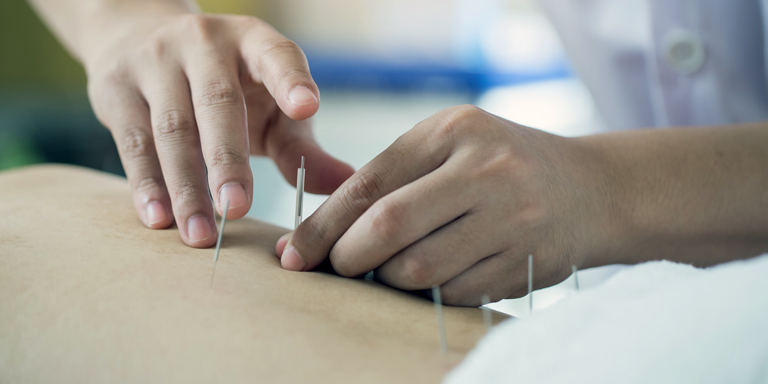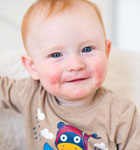Complementary medicine
The aha! Swiss Allergy Centre provides independent information about complementary medicine methods relating to allergies, the skin and asthma.

Table of contents:
According to sufferers, alternative treatment methods can help alleviate symptoms alongside conventional medical treatments..
Complementary therapies
covers a range of health care practices that can be used alongside conventional medicine. This includes both treatment systems such as traditional Chinese medicine (TCM) and vitamin and trace element supplements such as vitamin C and selenium. Alternative treatments commonly used in Switzerland include acupuncture and herbal medicine. (Source: www.iki.usz.ch)
Five complementary medicine methods have equal status to conventional medical disciplines since the regulation of 1 August 2017 and are therefore reimbursed under statutory health insurance. These are briefly described below.
Anthroposophical medicine
Anthroposophical medicine is based on the ideas of Rudolf Steiner and was founded by him and Dr Ita Wagner. It is conceived as an extension of conventional medicine and takes into account not only psychological principles but also spiritual and mental dimensions. The basis of anthroposophical medicine is the proposition that the human body unites four dimensions: the ego, the astral or feeling body, the etheric or life body and the physical body. These four dimensions work in harmony. If one dimension becomes dominant, this harmony is disturbed, resulting in illness. The aim of treatment is to restore the correct balance between these four dimensions.
Anthroposophical remedies are made up of substances of mineral, herbal and animal origin, which are intended to stimulate and support self-healing.
Homeopathy
The founder of homeopathy was Samuel Hahnemann. Following self-application of cinchona, the bark of a Peruvian tree, he described the law of similars (simila similibus curentur = like cures like) as the basis of homeopathy. According to homeopathy, illness results when the life force (dynamis) is disturbed. This disturbance is caused by harmful external stimuli and manifests as symptoms. The appropriate remedy should be based not only on the symptoms but also on the character of the patient. Healing is achieved by prescribing a remedy that produces a form of artificial disease that restores the disturbed life force.
Homeopathic remedies are mostly plant, animal or mineral-based. The starting material is potentiated, i.e diluted and vigorously shaken, and the medicines are therefore highly diluted when they are finally used. What medicinal substance is used at what potentiation is determined by the homeopathy specialist based on a detailed medical history.
Herbal medicine
Plants have been used since antiquity and employed for medicinal purposes in all forms of traditional medicine. Herbal medicines differ from conventional medicines in that they do not consist of precisely defined substances but are a blend of different substances considered in their entirety as a medicine. Herbal treatment is based on the medicinal effects of different plants: anti-inflammatory, decongestant, spasmolytic (anti-spasmodic), anti-microbial, etc. The desired effect determines the plant to be used as treatment. They are most commonly administered in the form of teas, liquid extracts or dry extracts, or plant parts can be eaten crushed.
Traditional Chinese medicine (TCM)
Traditional Chinese medicine (TCM) is a system of medicine that developed in China out of Taoism more than 2,500 years ago. It includes the concept of yin and yang, which shows how everything is interconnected. According to TCM, qi is the vital energy that flows in channels, the meridians.
The five elements of wood, fire, earth, metal and water describe the eternal cycle of nature. It is postulated in TCM that an imbalance in one of these elements results in corresponding symptoms and diseases. An imbalance may be caused by emotions (e.g. anger, joy/excitement), the environment (e.g. wind, cold, dryness) or other factors (e.g. incorrect diet, injury). Health is maintained and disease treated by ensuring these elements are in balance. This can be achieved by using the following methods alone or in combination: acupuncture, cupping, Chinese medicines, Chinese nutrition therapy, qigong and tai chi and Tuina massage.
Acupuncture
Acupuncture is part of traditional Chinese medicine and is based on the concept that the body is traversed by channels, meridians, through which qi flows. Located on the meridians are acupuncture points, where the flow of qi can be controlled. An acupuncture point may have different functions. Needles are inserted into the corresponding acupuncture points depending on the symptoms. In addition to traditional acupuncture, there is also acupressure, a massage technique applied to acupuncture points, as well as ear acupuncture, which is based on the concept that all areas of the body are represented in the ear).
Source: Checkliste Komplementärmedizin, Roman Huber, Andreas Michalsen (ed.), Haug Verlag
Editors: aha! Swiss Allergy Centre in co-operation with the Scientific Advisory Board.

